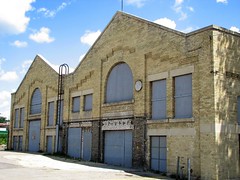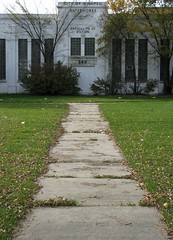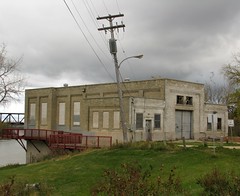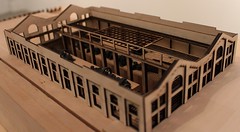Address: 109 James Avenue (Map)
Built: 1906 - 1908
Architect: H. N. Ruttan
Prior to 1919 Winnipeg's water system was made up of a series of wells and low pressure pumping stations, such as the McPhillips Street Station, that distributed it around the city.
For fire suppression there was a network of fire hydrants but they were fed at the same pressure as households. It was up to the fire wagons of the day to provide the additional pressure. Some large buildings constructed after 1900, such as Eaton's and the Kemp Manufacturing Building, included their own water reservoirs and pump systems to get around this problem.
 Bullman fire devastation, (source)
Bullman fire devastation, (source)Newspapers regularly reported large, devastating fires that razed entire blocks in other cities and towns. Winnipeg had its own close call in 1904 when the Bullman Block at Bannatyne Avenue and Albert Street caught fire. It destroyed the Bullman Block, Ashdown's store and the upper stories of the Duffin and Baker (Birt Saddlery) Block before fire fighters got it under control. If it had continued a few doors to the north it would have reached the newly built Union Bank Tower, Winnipeg's first skyscraper.
Due to low water pressure during the fire, water had to be pumped into the system directly from the Assiniboine River. The result was the contamination of the drinking water supply and the worsening of an ongoing typhoid epidemic. In 1904 there were double the number of cases compared to the year before and 133 deaths, (source.)
December 13, 1904, Manitoba Free Press
It was clear that the city needed a high pressure water system to fight fires. The Board of Trade passed a resolution in December 1904 calling on the city to provide one for the downtown commercial district and agreed to pay 40% of the bill. The resolution received a warm reception at city hall, which was no surprise given that the council was made up of local businessmen.
It was up to city engineer Henry Ruttan to find the system that would work best for Winnipeg. He looked to places like Philadelphia which had just rolled out North America's newest and finest fire suppression system.
Ruttan's system wouldn't impact Winnipeg's drinking water supply in any way. Water would be drawn from the Red River through a pump house into a pumping station that contained four, 540 horsepower "Otto" engines by Crossley Brothers of Manchester, England. These engines were powered from an on-site, coal-fired generating station, (now demolished.)
Ca. 1980 (Historic Buildings Report)
The engines would be on stand-by and manned 24 hours a day, 7 days a week. When a call came from the fire department in a matter of minutes the system's network of 7.25 miles of high pressure water mains and 78 hydrants would be ready to deliver between 200 and 300 pounds per square inch of pressure - enough to send a stream of water up to 700 feet in the air.
The James Avenue site was chosen in 1905 for its access to the Red River and to rail lines for the constant coal supply that would be needed. Construction contracts were let in late summer 1906.
October 25, 1907, Manitoba Free Press
On October 24, 1907 the first test of the system took place. Others followed in the days to come and soon the system was ready for action.
October 10, 1986, Winnipeg Free Press
Aside from the conversion from river water to Shoal Lake water and from coal-powered generators to gas, the system continued to operate until October 10, 1986 when it was taken out of service. The building was shuttered.
There have been a number of potential suitors for the building. Through the late 1980s and 1990s the most mentioned reuse was as part of a science and technology museum, though it appears that nobody ever floated a firm plan for such a venture. In the late 1990s a deal to turn it into a brew pub with a museum component fell through.
In 2001 CentreVenture sold the building to Peter Ginakes and Bob Harris for $150,000. In 2004 they ended up buying it back for $750,000 but found that one of the Crossley engines had been removed without permission and gifted to the Austin's Thresherman's museum for a "substantial" tax receipt. Other pump equipment was also missing, (August 11, 2004, Winnipeg Free Press p. B1.)
There have been other people interested in the property but the substantial costs relating to land remediation and cleaning of the equipment, in return for very little usable floor space, stopped them in their tracks. As development and demand for land increases along Waterfront, time is running out for the building. It is owned by CentreVenture, the City of Winnipeg's development company.
UPDATE - AUGUST 2013
On August 6, 2013 an open house was held to present a new (and likely the last) development idea for the site. It would require driving piles through the floor and adding a mixed-use, fourteen-storey tower on top. It would have a restaurant and market on the first two floors, three floors of office space and the rest rental apartments.
A catwalk and suspended floor above the machinery level would provide the space for restaurant and cafe seating. A key component will be the city / province proceeding with a parkade in the East Exchange.
For more photos.
Related:
Firewater: The James Avenue Pumping Station MB Historical Society
James Avenue Pumping Station APEGM
James Avenue Pumping Station TimeLinks / MHS
James Avenue Pumping Station Heritage Winnipeg
James Avenue High pressure Pumping Station Historic Buildings Committee
Media:
Bold new plan for pumphouse Free Press (Aug 2013)
Pumped to be an accidental activist Free Press (Aug 2012)
Pumping Station Still Feeling the Pressure Free Press (July 2012)
Looking for a future for the James Avenue pumping station CBC (Jul 2012)
Pumping Station Conundrum Free Press (Jul 2012)
What might have been at the pumping station Free Press (July 2012)











No comments:
Post a Comment